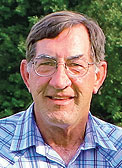
Keith Stevens, and his wife Beverly, call western Polk County, Mo., home, but much of his time is spent on the road, traveling to various county cattlemen’s meetings, agricultural events and visiting with legislators promoting policy in Jefferson City and Washington D.C.
Keith is serving as the 2016-2017 Missouri Cattlemen’s Association (MCA) president. The Stevens, along with Les and Donna Hopkins, own and operate B & L Hopkins Farms, located near Bolivar, Mo.
“I owe much appreciation to my brother-in-law, Les, for taking care of things on the farm while I am running around the state or fulfilling my duties as president,” Keith said.
The cow-calf operation consists of 50 head of crossbred beef cattle that are intensively grazed. They use Angus bulls, but their cows are a colorful mix of Braunvieh, Charolais, Limousin and Angus, which are bred to calve in the fall.
“With the single calving period, it gives us the opportunity to leave the calves with the cows a little longer because we are getting the bulls out,” explained Keith, who said they usually wean their calves between 7 and 8 months of age. “This gives them that little extra boost as they are adapting. We do the cross fencing weaning. I love that. It is eliminating so many issues and stress on the animal.”
Keith started building the grazing operation in 2003 when he partnered with the Natural Resources Conservation Service (NRCS).
Throughout the course of a year, he set up the intensive grazing system and installed watering systems. The pastures were primarily fescue, so Keith over-seeded clovers and orchardgrass to increase forage quality. By making these changes, he was able to increase the herd size from 35 to 50 cows.
“Grazing gives you so much diversity,” Keith explained. “What we have seen with doing the rotation are plants that were not there before. If you graze it at the right time you can promote the growth of warm-season grass or you can graze it at a different time and you will see your cool-season grass or your clover come out,” he explained.
Keith will graze the cattle to promote the growth of the strong forage type in the field. One of his pastures consists of a natural stand of native warm-season grasses, such as Bluestem and Indiangrass.
“We always work it in sometime in the summer,” he added. “We were able to produce all our hay and everything we needed on the same land from management of the grazing.”
Over the years, Keith has continued to improve the grazing program and now he is at the point where he quit haying the farm. He will graze all of the pastures and purchase needed hay.
“This year we made it almost all the way through to green-up,” Keith said.
He has tightened the rotation down to moving the cattle into a different paddock every two days. This allows the operation to retain their calves longer and sell them as yearlings, at a heavier weight.
“Once the calves are weaned, we will split rotation. We will run the calves in front of the cows so they are getting the premium grass and let the cows clean up afterward,” Keith added.
Rotational grazing has proved beneficial for the farm, especially during the drought of 2012.
“It really saved us,” Keith explained. “I had a lot of people say ‘How in the world do you still have grass?’” he said.
During that time, Keith opted to not graze the grass as short as he normally would and move them on to the next pasture.
“We strip grazed it and moved them each day. We got two weeks out of the warm-season field,” he said.
Whenever he had to feed hay, Keith would put the cows in a small pasture and feed them until the grass recovered.
“We got through 2012. The grazing gave us a defense against the drought. We didn’t have to sell cows,” Keith remarked.
Keith has noticed other benefits of utilizing rotational grazing.
“It’s a natural weed control. Confined cattle will graze undesirable forage and weeds to promote grass,” he said.
Keith has also seen an improvement in overall herd health. “Every two days, the cows and calves are moved to a new pasture, so if there is a health issue, it has been left behind.”
This decreased exposure to disease and parasites, along with administering preventive vaccines and deworming practices, results in a healthy, productive herd.
“In my opinion, if it’s good for the land, it’s good for the animal; and if it’s good for an animal, it’s good for us as producers,” Keith remarked.
“I have enjoyed serving in various leadership roles in the Missouri Cattleman’s Association. I have served as vice president, president-elect, and currently, president. I take pride in the opportunity to advocate on behalf of the beef industry,” said Keith. “I would like to encourage producers to join MCA.
Keith works for Ash Grove Aggregates as outside sales and quality control. He, and his wife Beverly, have one daughter Kalyn Cushard; son-in-law, Kyle; and grandson, Gage.







